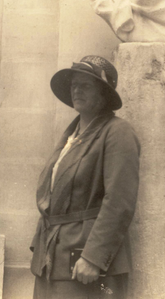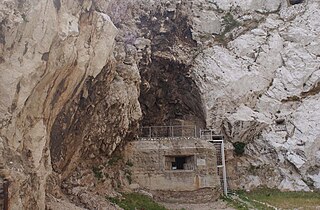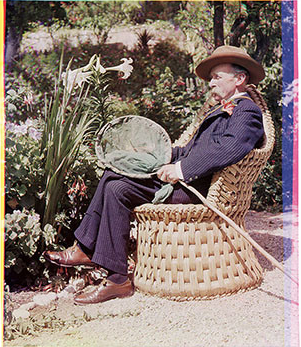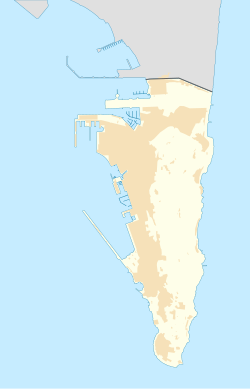
Cro-Magnon is an Aurignacian site, located in a rock shelter at Les Eyzies, a hamlet in the commune of Les Eyzies-de-Tayac-Sireuil, Dordogne, southwestern France.

Shanidar Cave is an archaeological site located on Bradost Mountain, within the Zagros Mountains, in the Erbil Governorate of Kurdistan Region in northern Iraq. It is known for the discovery of Neanderthal remains at the site, most notably Shanidar 1, who survived several injuries during his life, possibly due to care from others in his group, and Shanidar 4, the famed 'flower burial'. Until this discovery, Cro-Magnons, the earliest known H. sapiens in Europe, were the only individuals known for purposeful, ritualistic burials.

The Rock of Gibraltar is a monolithic limestone promontory located in the British territory of Gibraltar, near the southwestern tip of Europe on the Iberian Peninsula, and near the entrance to the Mediterranean. It is 426 m (1,398 ft) high. Most of the Rock's upper area is covered by a nature reserve, which is home to around 300 Barbary macaques. These macaques, as well as a labyrinthine network of tunnels, attract many tourists each year.
Below are notable events in archaeology that occurred in 1926.

Dorothy Annie Elizabeth Garrod, CBE, FBA was an English archaeologist who specialised in the Palaeolithic period. She held the position of Disney Professor of Archaeology at the University of Cambridge from 1939 to 1952, and was the first woman to hold a chair at either Oxford or Cambridge.

La Ferrassie 1, often referred to as LF1, is a male Neanderthal skeleton estimated to be 58–50,000 years old. It was discovered at the La Ferrassie site in France by Louis Capitan and Denis Peyrony in 1909. The skull is the most complete Neanderthal skull ever found. With a cranial capacity of 1641 cm3, it is the second largest hominid skull ever discovered, after Amud 1, another Neanderthal.

Gorham's Cave is a sea-level cave in the British overseas territory of Gibraltar. Though not a sea cave, it is often mistaken for one. Considered to be one of the last known habitations of the Neanderthals in Europe, the cave gives its name to the Gorham's Cave complex, which is a combination of four distinct caves of such importance that they are combined into a UNESCO World Heritage Site, the only one in Gibraltar. The three other caves are Vanguard Cave, Hyaena Cave, and Bennett's Cave.

Feldhofer 1 or Neanderthal 1 is the scientific name of the 40,000-year-old type specimen fossil of the species Homo neanderthalensis, discovered in August 1856 in a German cave, the Kleine Feldhofer Grotte, in the Neandertal valley, 13 km (8.1 mi) east of Düsseldorf. In 1864, the fossil's description was first published in a scientific magazine and officially named.

Teshik-Tash 1 is a Neanderthal skeleton discovered in 1938 in Teshik-Tash Cave, in the Bajsuntau mountain range, Uzbek SSR (Uzbekistan), Central Asia.

Dorothea Minola Alice Bate FGS, also known as Dorothy Bate, was a Welsh palaeontologist and pioneer of archaeozoology. Her life's work was to find fossils of recently extinct mammals with a view to understanding how and why giant and dwarf forms evolved.

Neanderthal anatomy differed from modern humans in that they had a more robust build and distinctive morphological features, especially on the cranium, which gradually accumulated more derived aspects, particularly in certain isolated geographic regions. This robust build was an effective adaptation for Neanderthals, as they lived in the cold environments of Europe. In which they also had to operate in Europe's dense forest landscape that was extremely different from the environments of the African grassland plains that Homo sapiens adapted to with a different anatomical build.

Mugharet el-Zuttiyeh is a prehistoric archaeological site in Upper Galilee, Israel. It is situated 800 m (2,600 ft) from the Nahal Amud outlet, approximately 30 m (98 ft) above the wadi bed. It was found to house a fossil today known as the "Galilee skull" or "The Yabrudian Man".

Gibraltar 1 is the name given to a Neanderthal skull, also known as the Gibraltar Skull, which was discovered at Forbes' Quarry in Gibraltar. The skull was presented to the Gibraltar Scientific Society by its secretary, Lieutenant Edmund Henry Réné Flint, on 3 March 1848. It is important to note that this discovery predates the finding of the Neanderthal type specimen.

Forbes' Quarry is located on the northern face of the Rock of Gibraltar within the Upper Rock Nature Reserve in the British Overseas Territory of Gibraltar. The area was quarried during the 19th century to supply stone for reinforcing the fortress' military installations. In the course of the quarrying, a limestone cave was found. The second ever Neanderthal discovery was made within this cave when Cpt. Edmund Flint found the skull of an adult female Neanderthal in 1848.
Gibraltar 2, also known as Devil's Tower Child, represented five skull fragments of a male Neanderthal child discovered in the British Overseas Territory of Gibraltar. The discovery of the fossils at the Devil's Tower Mousterian rock shelter was made by archaeologist Dorothy Garrod in 1926. It represented the second excavation of a Neanderthal skull in Gibraltar, after Gibraltar 1, the second Neanderthal skull ever found. In the early twenty-first century, Gibraltar 2 underwent reconstruction.

Cueva de la Pileta is a cave in the province of Málaga (Spain) which has cave paintings and was discovered in 1905.
Devil's Tower Cave is a cave in the British Overseas Territory of Gibraltar. Archaeologist Dorothy Garrod found a Neanderthal skull in the cave which, together with other evidence found in this cave, shows it was used as a rock shelter by the Neanderthals of Gibraltar.

Colonel William Willoughby Cole Verner was a British soldier, writer, ornithologist, and inventor of a type of compass. He was briefly a Professor of Topography at the Royal Military Academy Sandhurst. He is remembered for bringing Cueva de la Pileta, a cave filled with prehistoric paintings, to international attention.

The Neanderthals in Gibraltar were among the first to be discovered by modern scientists and have been among the most well studied of their species according to a number of extinction studies which emphasize regional differences, usually claiming the Iberian Peninsula partially acted as a “refuge” for the shrinking Neanderthal populations and the Gibraltar population of Neanderthals as having been one of many dwindling populations of archaic human populations, existing just until around 42,000 years ago. Many other Neanderthal populations went extinct around the same time.

Engis 2 refers to part of an assemblage, discovered in 1829 by Dutch physician and naturalist Philippe-Charles Schmerling in the lower of the Schmerling Caves. The pieces that make up Engis 2 are a partially preserved calvaria (cranium) and associated fragments of an upper and a lower jaw, a maxillary bone and an upper incisor tooth of a two to three year old Neanderthal child. The Schmerling Caves are situated just north of the Belgian municipality Engis, whence the name of this group. In 1833 Schmerling described and publicized the find, which included animal bones and stone tools. Recognizing their old age, he associated them with the "Ethiopian Type" of the diluvial period. Although it was not recognized as such until 1936, the publication represents the first scientific description of a Neanderthal fossil.


















